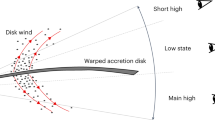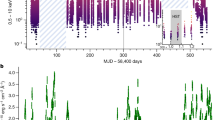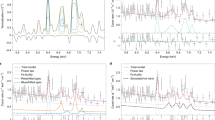Abstract
Accretion of matter onto black holes is universally associated with strong radiative feedback1 and powerful outflows2. In particular, black-hole transients3 have outflows whose properties4 are strongly coupled to those of the accretion flow. This includes X-ray winds of ionized material, expelled from the accretion disk encircling the black hole, and collimated radio jets5,6. Very recently, a distinct optical variability pattern has been reported in the transient stellar-mass black hole V404 Cygni, and interpreted as disrupted mass flow into the inner regions of its large accretion disk7. Here we report observations of a sustained outer accretion disk wind in V404 Cyg, which is unlike any seen hitherto. We find that the outflowing wind is neutral, has a large covering factor, expands at one per cent of the speed of light and triggers a nebular phase once accretion drops sharply and the ejecta become optically thin. The large expelled mass (>10−8 solar masses) indicates that the outburst was prematurely ended when a sizeable fraction of the outer disk was depleted by the wind, detaching the inner regions from the rest of the disk. The luminous, but brief, accretion phases shown by transients with large accretion disks2 imply that this outflow is probably a fundamental ingredient in regulating mass accretion onto black holes.
This is a preview of subscription content, access via your institution
Access options
Subscribe to this journal
Receive 51 print issues and online access
$199.00 per year
only $3.90 per issue
Buy this article
- Purchase on Springer Link
- Instant access to full article PDF
Prices may be subject to local taxes which are calculated during checkout



Similar content being viewed by others
Change history
01 June 2016
: A citation to Extended Data Fig. 6 in the Methods was corrected to Extended Data Fig. 5.
References
Fabian, A. C. Observational evidence of active galactic nuclei feedback. Annu. Rev. Astron. Astrophys. 50, 455–489 (2012)
Fender, R. P. & Belloni, T. M. GRS 1915+105 and the disc-jet coupling in accreting black hole systems. Annu. Rev. Astron. Astrophys. 42, 317–364 (2004)
Belloni, T. M., Motta, S. E. & Muñoz-Darias, T. Black hole transients. Bull. Astron. Soc. India 39, 409–428 (2011)
Fender, R. P. & Muñoz-Darias, T. in Astrophysical Black Holes. Lecture Notes in Physics. Vol. 905, 65–100 (eds Haardt, F. et al.) (Springer, 2016)
Ponti, G. et al. Ubiquitous equatorial accretion disc winds in black hole soft states. Mon. Not. R. Astron. Soc. 422, L11–L15 (2012)
Neilsen, J. & Lee, J. C. Accretion disk winds as the jet suppression mechanism in the microquasar GRS 1915+105. Nature 458, 481–484 (2009)
Kimura, M. et al. Repetitive patterns in rapid optical variations in the nearby black-hole binary V404 Cygni. Nature 529, 54–58 (2016)
Casares, J., Charles, P. A. & Naylor, T. A 6.5-day periodicity in the recurrent nova V404 Cygni implying the presence of a black hole. Nature 355, 614–617 (1992)
Miller-Jones, J. C. A. The first accurate parallax distance to a black hole. Astrophys. J. 706, L230–L234 (2009)
Barthelmy, S. D. et al. Swift trigger 643949 is V404 Cyg. GRB Coord. Netw. Circ. 17929 http://gcn.gsfc.nasa.gov/gcn/gcn3/17929.gcn3 (2015)
Rodriguez, J. et al. Correlated optical, X-ray, and γ-ray flaring activity seen with INTEGRAL during the 2015 outburst of V404 Cygni. Astron. Astrophys. 581, L9 (2015)
Martí, J., Luque-Escamilla, P. L. & García-Hernáncez, M. T. Multi-colour optical photometry of V404 Cygni in outburst. Astron. Astrophys. 586, A58 (2016)
Muñoz-Darias, T. et al. Detection of transient optical P-Cygni profiles in V404 Cyg. Astron. Telegr. 7659 (2015)
Mauche, C. W. & Raymond, J. C. IUE observations of the dwarf nova HL Canis Majoris and the winds of cataclysmic variables. Astrophys. J. 323, 690–713 (1987)
Castor, J. I. & Lamers, H. J. G. L. M. An atlas of theoretical P Cygni profiles. Astrophys. J. Suppl. Ser. 39, 481–511 (1979)
Begelman, M. C., McKee, C. F. & Shields, G. A. Compton heated winds and coronae above accretion disks. I. Dynamics. Astrophys. J. 271, 70–88 (1983)
King, A. L. et al. High-resolution Chandra HETG spectroscopy of V404 Cygni in Outburst. Astrophys. J. 813, L37 (2015)
Drake, A. S. & Ulrich, R. K. The emission-line spectrum from a slab of hydrogen at moderate to high densities. Astrophys. J. Suppl. Ser. 42, 351–383 (1980)
Iijima, T. & Esenoglu, H. H. Spectral evolution of Nova (V1494) Aql high velocity jets. Astron. Astrophys. 404, 997–1009 (2003)
Thackeray, A. D. Spectra of the low-excitation nebulosities around AG Carinae and HD 138403. Mon. Not. R. Astron. Soc. 180, 95–102 (1977)
Smith, N., Mauerhan, J. C. & Prieto, J. L. SN 2009ip and SN 2010mc: core-collapse Type IIn supernovae arising from blue supergiants. Mon. Not. R. Astron. Soc. 438, 1191–1207 (2014)
Zycki, P. T., Done, C. & Smith, D. A. The 1989 May outburst of the soft X-ray transient GS 2023+338 (V404 Cyg). Mon. Not. R. Astron. Soc. 309, 561–575 (1999)
Casares, J. A. FWHM-K2 correlation in black hole transients. Astrophys. J. 808, 80 (2015)
Armas Padilla, M. et al. Swift J1357.2–0933: the faintest black hole? Mon. Not. R. Astron. Soc. 444, 902–905 (2014)
Beardmore, A. P., Page, K. L. & Kuulkers, E. Swift triggers on V404 Cyg. Astron. Telegr. 8455 (2015)
Casares, J., Charles, P. A., Jones, D. H. P., Rutten, R. G. M. & Callanan, P. J. Optical studies of V404 Cyg, the X-ray transient GS2023+338. I. The 1989 outburst and decline. Mon. Not. R. Astron. Soc. 250, 712–725 (1991)
Corral-Santana, J. M. et al. BlackCAT: a catalogue of stellar-mass black holes in X-ray transients. Astron. Astrophys. 587, A61 (2016)
Lindstrøm, C. et al. New clues on outburst mechanism and improved spectroscopic elements of the black hole binary V4641 Sagittarii. Mon. Not. R. Astron. Soc. 363, 882–890 (2005)
Nielsen, J., Remillard, R. A. & Lee, J. C. The physics of the Heartbeat State of GRS 1915+105. Astrophys. J. 737, 69 (2011)
Feruglio, C. et al. Quasar feedback revealed by giant molecular outflows. Astron. Astrophys. 518, L155 (2010)
Chen, W., Schrader, C. R. & Livio, M. The properties of X-ray and optical light curves of X-ray novae. Astrophys. J. 491, 312–338 (1997)
Groot, P. J., Rutten, R. G. M. & van Paradijs, J. SW Sextantis in an excited, low state. Astron. Astrophys. 368, 183–196 (2001)
Winkler, C. et al. The INTEGRAL mission. Astron. Astrophys. 411, L1–L6 (2003)
Kuulkers, E. INTEGRAL observations of V404 Cyg (GS 2023+338): public data products Astron. Telegr. 7758 (2015)
Lebrun, F. et al. ISGRI: the INTEGRAL Soft Gamma-Ray Imager. Astron. Astrophys. 411, L141–L148 (2003)
Rodriguez, J. et al. Spectral state dependence of the 0.4-2 MeV polarized emission in Cygnus X-1 seen with INTEGRAL/IBIS, and links with the AMI radio data. Astrophys. J. 807, 17 (2015)
Burrows, D. N. et al. The Swift X-ray telescope. Space Sci. Rev. 120, 165–195 (2005)
Mooley, K. P. et al. Bright radio flaring from V404 Cyg detected by AMI-LA. Astron. Telegr. 7658 (2015)
Staley, T. D. & Anderson, G. E. Chimenea and other tools: automated imaging of multi-epoch radio-synthesis data with CASA. Astron. Comput. 13, 38–49 (2015)
Davies, M. L. et al. Follow-up observations at 16 and 33GHz of extragalactic sources from WMAP 3-yr data: I—spectral properties. Mon. Not. R. Astron. Soc. 400, 984–994 (2009)
McMullin, J. P., Waters, B., Schiebel, D., Young, W. & Golap, K. CASA architecture and applications. Astron. Soc. Pacif. Conf. Ser. 766, 127 (2007)
CASA Consortium. CASA: Common Astronomy Software Applications. Astrophys. Source Code Lib. ascl:1107.013, https://casa.nrao.edu (2011)
Casares, J. & Jonker, P. G. Mass measurements of stellar and intermediate-mass black holes. Space Sci. Rev. 183, 223–252 (2014)
King, A. R., Kolb, U. & Burderi, L. Black hole binaries and X-ray transients. Astrophys. J. 464, L127–L130 (1996)
Proga, D. & Kallman, T. R. On the role of the ultraviolet and X-ray radiation in driving a disk wind in X-ray binaries. Astrophys. J. 565, 455–470 (2002)
Shakura, N. I. & Sunyaev, R. A. Black holes in binary systems. Observational appearance. Astron. Astrophys. 24, 337–355 (1973)
Krautter, J. et al. IUE spectroscopy of cataclysmic variables. Astron. Astrophys. 102, 337–346 (1981)
Smith, N. & Arnett, W. D. Preparing for an explosion: hydrodynamic instabilities and turbulence in presupernovae. Astrophys. J. 785, 82 (2014)
Walton, D. et al. NuSTAR observation of V404 Cyg during/after decline. Astron. Telegr. 7752 (2015)
King, A. R. & Ritter, H. The light curves of soft X-ray transients. Mon. Not. R. Astron. Soc. 293, L42–L48 (1998)
Motta, S. E. et al. INTEGRAL and Swift observations of V404 Cyg: going back to quiescence? Astron. Telegr. 8510 (2016)
Cannizzo, J. K., Shafter, A. W. & Wheeler, J. C. On the outburst recurrence time for the accretion disk limit cycle mechanism in dwarf novae. Astrophys. J. 333, 227–235 (1988)
Acknowledgements
Nine of the spectra of 27 June were taken during the visit of King Felipe VI of Spain to the 10.4-m Gran Telescopio Canarias (GTC); we appreciate the support this visit provides to astrophysical research in Spain. This work is based on observations made with the GTC telescope, in the Spanish Observatorio del Roque de los Muchachos of the Instituto de Astrofísica de Canarias, during both Time Allocation Committee and Director’s Discretionary observing time. We are thankful to the GTC team for the fast response and efficient work throughout the observing campaign. We acknowledge support by the Spanish Ministerio de Economía y competitividad under grants AYA2013-42627 and PSR2015-00397, the Leverhulme Trust Visiting Professorship Grant VP2-2015-046, the International Research Fellowship program of the Japan Society for the Promotion of Science (PE15024), the Bundesministerium für Wirtschaft und Technologie (BMWI/DLR, FKZ 50 OR 1408) and the French Research National Agency’s CHAOS project ANR-12-BS05-0009. The use of the MOLLY software developed by T. R. Marsh is gratefully acknowledged.
Author information
Authors and Affiliations
Contributions
T.M.-D. performed the GTC data analysis and wrote the paper. J.C. contributed to the GTC data analysis and assisted in writing the paper. D.M.S. performed the GTC data reduction and contributed to the GTC data analysis. R.P.F. provided the radio data and contributed to the scientific discussion. M.A.P. performed X-ray analysis and contributed to the scientific discussion. M.L. provided day-12 GTC spectra and assisted in writing the paper. G.P. contributed to the scientific discussion. P.A.C. contributed to the scientific discussion and assisted in writing the paper. K.P.M. performed radio data analysis. J.R. provided part of the INTEGRAL data.
Corresponding author
Ethics declarations
Competing interests
The authors declare no competing financial interests.
Extended data figures and tables
Extended Data Figure 1 Evolution of the main parameters during the outburst.
Zero time is set to 17 June 00:00 UT. From top to bottom we show hard (25–200 keV) and soft (0.5–10 keV) normalized X-ray count rates, radio flux (~16 GHz), optical continuum flux, He I λ = 5,876 Å equivalent width (EW; positive for absorption) in the range −3,000 km s−1 to 0 km s−1 and Hα equivalent width. The Balmer decrement (black) and Iratio (red) are shown in the bottom panel. In the top panel, X-rays have been normalized to their respective peak at ~LEdd and the time intervals corresponding to the GTC observations have been greyed out for clarity.
Extended Data Figure 2 Trail spectrum showing GTC spectra taken during days 1–6.
P Cyg profiles are apparent in seven transitions of neutral hydrogen (Hα and Hβ) and helium. The strongest are observed in days 1, 2 and 6, being more prominent in the He I λ = 5,876 Å transition. Similar profiles are seen in another five transitions at shorter wavelengths (not shown).
Extended Data Figure 3 Gaussian fits to the P Cyg profiles.
From top to bottom we show the optical flux, terminal (dots) and mean (triangles) velocities, and emission (red dots) and absorption amplitudes (blue dots) of the P Cyg profiles. The two bottom panels result from a Gaussian fitting after subtracting the disk component from the emission (Methods). Terminal velocities in the range VT = 1,500–2,000 km s−1 are observed (see Fig. 2). This method yields VT = 3,000 km s−1 for day 6 (see Fig. 1). The amplitude of the profile is correlated with the optical flux. The similar (if not higher) amplitude of the emission component implies that the wind has a large covering factor. Error bars indicate the standard error of the mean.
Extended Data Figure 4 Evolution of the Hα emission line.
The top panel shows the evolution of the centroid of the Hα line. Positive velocity values are due to line asymmetries by blue absorption and red emission. The bottom panel shows the V/R parameter (the emission line is symmetric if V/R = 1) showing the same phenomena. This strongly suggests the presence of continuous outflows from the outer disk along the whole outburst. Error bars indicate the standard deviation of measurements within each observing window.
Extended Data Figure 5 BD evolution through the nebular phase.
From day 10, the BD is observed to increase sharply, reaching ~5 on day 11 and ~6 on day 12 (see Methods). Dotted lines join observations consecutive in time. Error bars indicate the standard error of the mean.
Rights and permissions
About this article
Cite this article
Muñoz-Darias, T., Casares, J., Sánchez, D. et al. Regulation of black-hole accretion by a disk wind during a violent outburst of V404 Cygni. Nature 534, 75–78 (2016). https://doi.org/10.1038/nature17446
Received:
Accepted:
Published:
Issue Date:
DOI: https://doi.org/10.1038/nature17446
This article is cited by
-
Frontiers in accretion physics at high X-ray spectral resolution
Nature Astronomy (2022)
-
A persistent ultraviolet outflow from an accreting neutron star binary transient
Nature (2022)
-
The Voyage of Metals in the Universe from Cosmological to Planetary Scales: the need for a Very High-Resolution, High Throughput Soft X-ray Spectrometer
Experimental Astronomy (2021)
-
The high energy Universe at ultra-high resolution: the power and promise of X-ray interferometry
Experimental Astronomy (2021)
-
A rapidly changing jet orientation in the stellar-mass black-hole system V404 Cygni
Nature (2019)
Comments
By submitting a comment you agree to abide by our Terms and Community Guidelines. If you find something abusive or that does not comply with our terms or guidelines please flag it as inappropriate.



